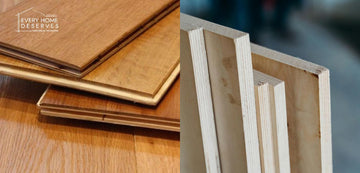
It's like choosing ingredients for a recipe, when picking out materials for your home furniture. Let's explore how engineered wood and plywood handle moisture, toughness, wear tear, maintenance and cost.
| Feature | Engineered Wood | Plywood |
| Composition | Wood fibers + Adhesive | Layers of wood veneer |
| Moisture Resistance | Limited; prone to damage | Good; handles dampness better |
| Toughness & Durability | Resistant; difficult to repair | Highly resistant; easier to repair |
| Cost | More affordable | Pricier but offers value |
| Maintenance | Low; simple wipe-down | Higher; requires more care |
| Ideal Use | Dry areas, minimal wear and tear | Kitchens, bathrooms, high-traffic areas |
Engineered Wood: Modern Choice for Nature
Engineered wood is like a modern kitchen gadget – sleek and multifunctional. It's made by combining wood fibers with adhesive and comes in several forms like MDF and HDF, each with its own special use.
Holding Up Against Moisture
While engineered wood can handle a bit of moisture, it's not the best swimmer. It can withstand a few splashes, but constant exposure to water can cause swelling or warping. So, it’s better for dry areas or where spills are cleaned up quickly.
Dealing with Damage
Engineered wood is tough against scratches and dents, especially the high-density varieties. In any case, if it does get damaged, fixing it can be tricky - fit's like trying to repair a chipped ceramic plate.
Plywood: The Sturdy Veteran
Plywood has been around for ages, and it's like an old, reliable cookbook – it has answers for almost everything. It's crafted by pressing layers of wood veneer together, and it’s known for its robustness.
Moisture: Less of a Worry
Plywood is better suited for areas that might get a bit wet. It’s like an umbrella in a drizzle – it keeps most of the water out. High quality plywood could actually face heavy dampness, which is the reason it's not used in washrooms and kitchens.
Toughness Over Time
Plywood is quite resistant to damage. It can take a hit and not show much wear – picture a well-used cricket bat still going strong. And if it gets scratched or chipped, it’s easier to repair than engineered wood.
Cost, Maintenance, and More
When it comes to cost, engineered wood often has a friendlier price tag, making it a good choice for budget-conscious projects. It's also low-maintenance; a simple wipe-down usually keeps it looking fresh.
Plywood may be a pricier, but its life span can make it worth the additional expense over the long run. It needs a bit more care, especially to keep it safe from too much water and extreme conditions.
Which One Should You Choose?
If you’re decking out a space that won’t see a lot of moisture and you want to keep your wallet happy, engineered wood is a solid choice. It’s also great if you want a smooth finish for painting or if you’re not expecting heavy wear and tear.
On the flip side, if you’re furnishing a kitchen, bathroom, or a high-traffic area and you want your investment to last longer, plywood is the way to go. It can handle the hustle and bustle of a busy home life better.
The bottom line? Match your choice to your home's needs, just like you’d pick the right attire for the right occasion – comfort, durability, and style all in one!






